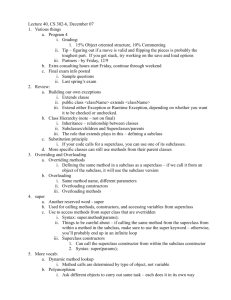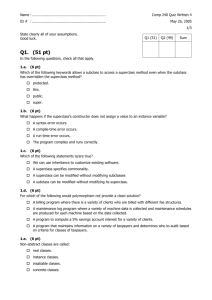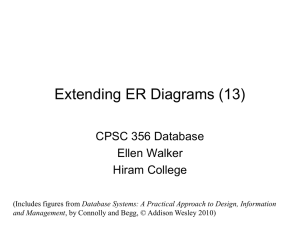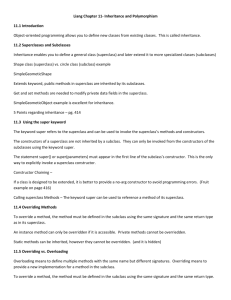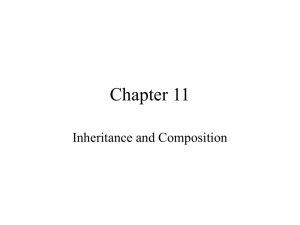10.2.2 Using Superclass References with Subclass
advertisement
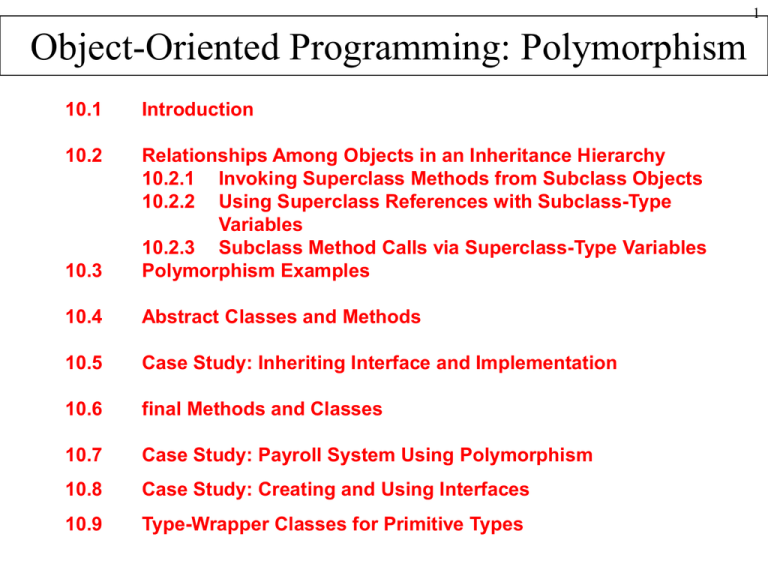
1
Object-Oriented Programming: Polymorphism
10.1
Introduction
10.2
10.3
Relationships Among Objects in an Inheritance Hierarchy
10.2.1 Invoking Superclass Methods from Subclass Objects
10.2.2 Using Superclass References with Subclass-Type
Variables
10.2.3 Subclass Method Calls via Superclass-Type Variables
Polymorphism Examples
10.4
Abstract Classes and Methods
10.5
Case Study: Inheriting Interface and Implementation
10.6
final Methods and Classes
10.7
Case Study: Payroll System Using Polymorphism
10.8
Case Study: Creating and Using Interfaces
10.9
Type-Wrapper Classes for Primitive Types
2
10.1 Introduction
• Polymorphism
– “Program in the general”
– Treat objects in same class hierarchy as if all superclass
– Abstract class
• Common functionality
– Makes programs extensible
• New classes added easily, can still be processed
• In our examples
– Use abstract superclass Shape
• Defines common interface (functionality)
• Point, Circle and Cylinder inherit from Shape
– Class Employee for a natural example
3
10.2 Relationships Among Objects in an
Inheritance Hierarchy
• Previously
– Circle inherited from Point
– Manipulated Point and Circle objects using references
to invoke methods
• This section
– Invoking superclass methods from subclass objects
– Using superclass references with subclass-type variables
– Subclass method calls via superclass-type variables
• Key concept
– subclass object can be treated as superclass object
• “is-a” relationship
• superclass is not a subclass object
4
10.2.1 Invoking Superclass Methods from
Subclass Objects
• Store references to superclass and subclass objects
– Assign a superclass reference to superclass-type variable
– Assign a subclass reference to a subclass-type variable
• Both straightforward
– Assign a subclass reference to a superclass variable
• “is a” relationship
..\..\week9\relationships_1
5
10.2.2 Using Superclass References with
Subclass-Type Variables
• Previous example
– Assigned subclass reference to superclass-type variable
• Circle “is a” Point
• Assign superclass reference to subclass-type
variable
– Compiler error
• No “is a” relationship
• Point is not a Circle
• Circle has data/methods that Point does not
– setRadius (declared in Circle) not declared in
Point
– Cast superclass references to subclass references
• Called downcasting
• Invoke subclass functionality
6
1
2
3
4
5
6
7
8
9
10
11
12
13
14
15
// HierarchyRelationshipTest2.java
// Attempt to assign a superclass reference to a subclass-type variable.
public class HierarchyRelationshipTest2 {
public static void main( String[] args )
{
Point3 point = new Point3( 30, 50 );
Circle4 circle; // subclass-type variable
// assign superclass reference to subclass-type variable
circle = point; // Error: a Point3 is not a Circle4
}
} // end class HierarchyRelationshipTest2
Assigning superclass reference
to subclass-type variable causes
compiler error
HierarchyRelationshipTest2.java:12: incompatible types
found
: Point3
required: Circle4
circle = point; // Error: a Point3 is not a Circle4
^
1 error
7
10.2.3 Subclass Method Calls via
Superclass-Type variables
• Call a subclass method with superclass reference
– Compiler error
• Subclass methods are not superclass methods
8
1
2
3
4
5
6
7
8
9
10
11
12
13
14
15
16
17
18
19
20
21
// HierarchyRelationshipTest3.java
// Attempting to invoke subclass-only member methods through
// a superclass reference.
public class HierarchyRelationshipTest3 {
public static void main( String[] args )
{
Point3 point;
Circle4 circle = new Circle4( 120, 89, 2.7 );
point = circle;
// aim superclass reference at subclass object
// invoke superclass (Point3) methods on subclass
// (Circle4) object through superclass reference
int x = point.getX();
int y = point.getY();
point.setX( 10 );
point.setY( 20 );
point.toString();
9
22
23
24
25
26
27
28
29
30
31
32
// attempt to invoke subclass-only (Circle4) methods on
// subclass object through superclass (Point3) reference
double radius = point.getRadius();
point.setRadius( 33.33 );
double diameter = point.getDiameter();
double circumference = point.getCircumference();
double area = point.getArea();
} // end main
} // end class HierarchyRelationshipTest3
Attempt to invoke subclassonly (Circle4) methods on
subclass object through
superclass (Point3)
reference.
HierarchyRelationshipTest3.java:24: cannot resolve symbol
symbol : method getRadius ()
location: class Point3
double radius = point.getRadius();
^
HierarchyRelationshipTest3.java:25: cannot resolve symbol
symbol : method setRadius (double)
location: class Point3
point.setRadius( 33.33 );
^
HierarchyRelationshipTest3.java:26: cannot resolve symbol
symbol : method getDiameter ()
location: class Point3
double diameter = point.getDiameter();
^
HierarchyRelationshipTest3.java:27: cannot resolve symbol
symbol : method getCircumference ()
location: class Point3
double circumference = point.getCircumference();
^
HierarchyRelationshipTest3.java:28: cannot resolve symbol
symbol : method getArea ()
location: class Point3
double area = point.getArea();
^
5 errors
10
11
10.3 Polymorphism Examples
• Examples
– Suppose Rectangle derives from Quadrilateral
• Rectangle more specific than Quadrilateral
• Any operation on Quadrilateral can be done on
Rectangle (i.e., perimeter, area)
• Suppose designing video game
– Superclass SpaceObject
• Subclasses Martian, SpaceShip, LaserBeam
• Contains method draw
– To refresh screen
• Send draw message to each object
• Same message has “many forms” of results
12
10.3 Polymorphism Examples
• Video game example, continued
– Easy to add class Mercurian
• Extends SpaceObject
• Provides its own implementation of draw
– Programmer does not need to change code
• Calls draw regardless of object’s type
• Mercurian objects “plug right in”
13
10.4 Abstract Classes and Methods
• Abstract classes
– Are superclasses (called abstract superclasses)
– Cannot be instantiated
– Incomplete
• subclasses fill in "missing pieces"
• Concrete classes
– Can be instantiated
– Implement every method they declare
– Provide specifics
14
10.4 Abstract Classes and Methods (Cont.)
• Abstract classes not required, but reduce client
code dependencies
• To make a class abstract
– Declare with keyword abstract
– Contain one or more abstract methods
public abstract void draw();
– Abstract methods
• No implementation, must be overridden
15
10.4 Abstract Classes and Methods (Cont.)
• Application example
– Abstract class Shape
• Declares draw as abstract method
– Circle, Triangle, Rectangle extends Shape
• Each must implement draw
– Each object can draw itself
• Iterators
– Array, ArrayList (Chapter 22)
– Walk through list elements
– Used in polymorphic programming to traverse a collection
16
10.5 Case Study: Inheriting Interface and
Implementation
• Make abstract superclass Shape
– Abstract method (must be implemented)
• getName, print
• Default implementation does not make sense
– Methods may be overridden
• getArea, getVolume
– Default implementations return 0.0
• If not overridden, uses superclass default implementation
– Subclasses Point, Circle, Cylinder
17
10.5 Case Study: Inheriting Interface and
Implementation
Shape
Point
Circle
Cylinder
Fig. 10.4 Shape hierarchy class diagram.
18
10.6 Case Study: Inheriting Interface and
Implementation
getArea
getVolume
getName
print
Shape
0.0
0.0
= 0
= 0
Point
0.0
0.0
"Point"
[x,y]
Circle
pr2
0.0
"Circle"
center=[x,y];
radius=r
2pr2 +2prh
pr2h
"Cylinder"
center=[x,y];
radius=r;
height=h
Cylinder
Polimorphic interface for the Shape hierarchy classes.
..\..\week9\case-study1
19
10.6 final Methods and Classes
• final methods
– Cannot be overridden
– private methods are implicitly final
– static methods are implicitly final
• final classes
– Cannot be superclasses
– Methods in final classes are implicitly final
– e.g., class String
20
10.7 Case Study: Payroll System Using
Polymorphism
• Create a payroll program
– Use abstract methods and polymorphism
• Problem statement
– 4 types of employees, paid weekly
•
•
•
•
Salaried (fixed salary, no matter the hours)
Hourly (overtime [>40 hours] pays time and a half)
Commission (paid percentage of sales)
Base-plus-commission (base salary + percentage of sales)
– Boss wants to raise pay by 10%
21
10.9 Case Study: Payroll System Using
Polymorphism
• Superclass Employee
– Abstract method earnings (returns pay)
• abstract because need to know employee type
• Cannot calculate for generic employee
– Other classes extend Employee
Employee
SalariedEmployee
CommissionEmployee
BasePlusCommissionEmployee
..\..\week9\case-study2
HourlyEmployee
22
10.8 Case Study: Creating and Using
Interfaces
• Use interface Shape
– Replace abstract class Shape
• Interface
– Declaration begins with interface keyword
– Classes implement an interface (and its methods)
– Contains public abstract methods
• Classes (that implement the interface) must implement these
methods
23
1
2
3
4
5
6
7
8
9
// Shape.java
// Shape interface declaration.
public interface
public double
public double
public String
Shape {
getArea();
getVolume();
getName();
Classes that implement Shape
must implement these methods
// calculate area
// calculate volume
// return shape name
} // end interface Shape
..\..\week9\case-study3
24
10.8 Case Study: Creating and Using
Interfaces (Cont.)
• Implementing Multiple Interface
– Provide common-separated list of interface names after
keyword implements
• Declaring Constants with Interfaces
– public interface
public static
public static
public static
}
Constants
final int
final int
final int
..\..\week9\case-study4
{
ONE = 1;
TWO = 2;
THREE = 3;
25
10.9 Type-Wrapper Classes for Primitive
Types
• Type-wrapper class
– Each primitive type has one
• Character, Byte, Integer, Boolean, etc.
– Enable to represent primitive as Object
• Primitive types can be processed polymorphically
– Declared as final
– Many methods are declared static
Check API.
